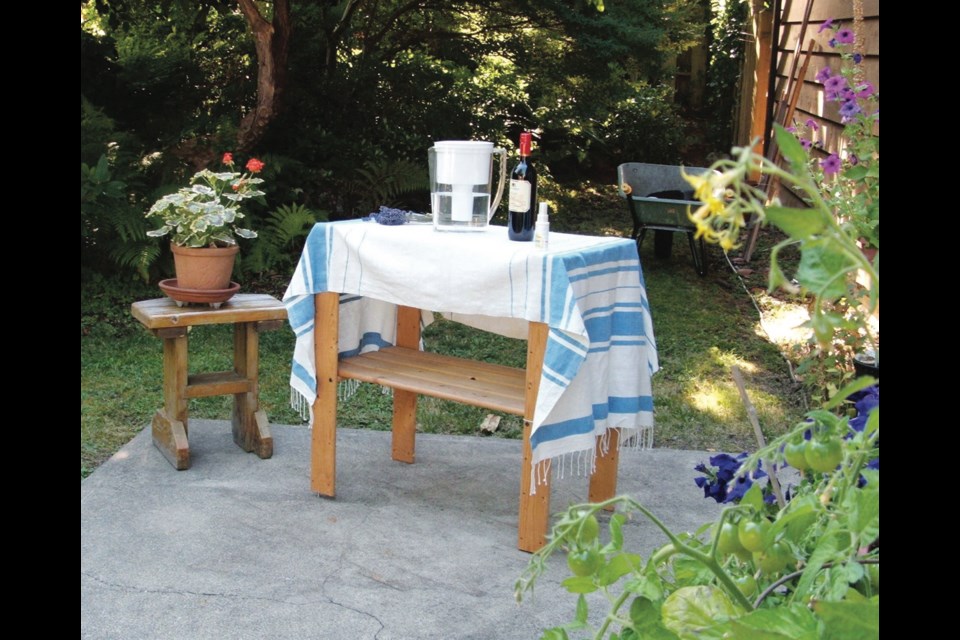How to characterize this summer? Dog days and garden parties come to mind.
“Dog days” are the hottest days of summer, named for Sirius, the Dog Star, whose rising ancient astrologers connected with heat, drought, sudden thunderstorms, lethargy, fever, mad dogs, and bad luck. Any of that ringing a bell?
As it happened, my pot luck group met for the first time since before COVID, on one of the warmest evenings of the summer, two weeks ago. We agreed to meet early, at 6 p.m., on my back lawn.
I arranged six chairs and small tables, spaced a little more than two metres apart, in an arc facing the garden with a table at the centre for placing food. For safety, everyone brought her own plate, utensils, and drink. I supplied paper serviettes and a supplementary “drinks” table with water, wine, and hand sanitizer. The downstairs bathroom, just off the carport, was sanitized and supplied with small, individual towels.
Everyone contributed take-out food in the form of pizzas and sushi, and they all brought their own tongs or chopsticks for serving themselves. For dessert there were individual tarts from a local coffee shop.
It was a perfect evening, warm and fragrant. Some of the women strolled through the garden and returned with questions. One wanted to know the names of the flowers in a patch of wildflowers and bee-friendly blooms in one of the plots. She saw many of them as perfect for a small flower garden next to one of her apartment windows.
She began growing flowers in the site this year. Among the most promising ones Marilyn saw were alyssum, candytuft, cornflower, clarkia, and baby blue eyes (Nemophila).
Pat remarked on the hydrangeas in the garden and asked about a problem with her sister’s white hydrangea: Why were the blooms turning pink? The most likely reasons: It is common, as the blooms age, to take on pink tones. The acid-alkaline balance (pH) of the soil can also affect hydrangea flower colour. Alkaline soils foster pink and red. Acidic soils help to keep blue hydrangeas true blue. A soil that is very slightly acidic is probably best for white hydrangeas.
As the light was starting to fade, on came the evening entertainment — The Raccoon Show. A family of raccoons, a mother and four babies, began disporting themselves close by, in a big fir tree next to my side fence and very close to the house. The babies were trying to overtake each other along the branches as the whole lot of them made their way down the tree. They tumbled over the fence onto a slope beside the house, where we were able to observe their antics further.
That raccoon family has been the talk of the neighbourhood as it travels about. I often see them crossing the patio on their way back to their tree. One morning I watched the mother shepherding the little ones down my driveway toward the street.
Not my favourite wild animal, but part of the scene around here.
That was not the end of the evening’s entertainment. With the departure of my friends around dusk, I’d gone to bed and had just fallen asleep when a mighty noise jolted me awake. Thunder, as I’d never heard it before, followed repeated flashes of sheet lightning in a continuing “Sound and Light” exhibit that must have been a massive collision of weather systems — or a dog days show.
Tale of two clematis vines. A surprise this summer has been strong growth and flowers on two clematis vines that have, over the years, come close to disappearing into the landscape.
I first planted a Barbara Dibley on a trellis alongside the carport. When the trellis was removed, I transplanted the vine beside a flowering quince shrub a neighbour had given me. The vine lives and blooms, minimally, in a bed I tend only occasionally, but this summer, it proceeded to dot the top of the shrub liberally with its impressive mauve-pink, carmine-striped flowers.
I thought the Clematis durandii that I planted at the base of a Rosa rubrifolia (R. glauca) had disappeared, but it wound its way up the spiny rose canes to produce gorgeous indigo-blue flowers. Perhaps it was the severe renewal pruning of the rose in late winter, and the compost mulching that followed. Anyway, the flowers were a welcome gift.



